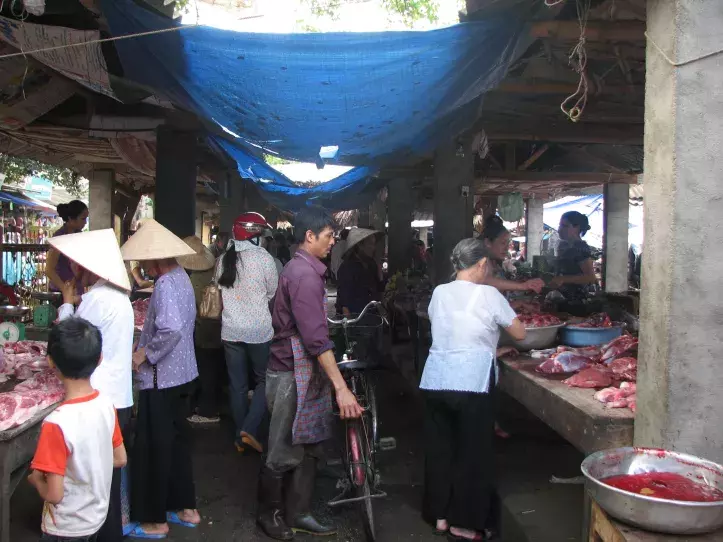Error message

By James H. Spencer, Sumeet Saksena, and Jefferson Fox
HONOLULU (1 April 2020)—The current COVID-19 pandemic, which started in Wuhan, China, underscores what the public health community has warned about for more than two decades—the risk of viral diseases capable of spreading from animal to human hosts. The first outbreaks of “bird flu” (highly pathogenic avian influenza―HPAI, subtype H5N1) raised similar concerns 20 years ago―concerns that have persisted with the outbreak of SARS in 2002–2004 and COVID-19 today. New outbreaks of avian influenza are also still occurring in poultry and humans, primarily in Asia but also in other parts of the world.
Several studies have suggested that unplanned, poorly serviced areas surrounding Asia’s cities are at special risk for outbreaks of emerging infectious diseases such as avian influenza or coronavirus. Today, the identification of possible links between disease outbreaks and urban growth is particularly critical because rural-to-urban migration is overwhelming the resources for urban planning all across Asia. Specifically, rapid urbanization is outpacing the provision of sanitation, clean water supplies, modern construction, and other infrastructure.
Urbanization and disease outbreaks in Vietnam
For a number of reasons, Vietnam offers a special opportunity to study possible links between urbanization and emerging infectious disease. Vietnam is urbanizing quickly, and the country has experienced major outbreaks of bird flu in its large and growing poultry industry. Outbreaks between 2003 and 2005 killed millions of chickens and, in a few troubling cases, “jumped” from infected birds into the human population.
At the same time, Vietnam has a strong, national-scale data collection and monitoring capability. The government collects and publishes detailed information on disease outbreaks, infrastructure development, and many other relevant factors from across the country.
Outbreaks most likely in the areas between rural and urban
A recent study compared information on infrastructure and other aspects of economic development in Vietnam with outbreaks of avian influenza. As expected, the study found that bird flu outbreaks were relatively rare in fully urban areas, where most or all houses had access to flush toilets, piped water, and modern building materials. Perhaps surprisingly, the rate of outbreaks was also low in the most rural areas, where most or all houses lacked access to these amenities. The rate of outbreaks was highest in “low-coherence” areas of mixed infrastructure development where, for example, some houses had flush toilets while others had pit latrines or no toilet at all. Such mixed access to modern amenities is characteristic of recent, unplanned settlements around cities.
This inverted u-shaped curve―with the lowest disease incidence in the least and the most developed areas and the highest in the mixed areas in between―was still visible after taking other potentially important factors into account. These included the size and density of local poultry populations, general measures of community modernization, the education level of the local population, and the overall capacity of local governments and related social organizations.
These research findings confirm observations that two parallel processes of urbanization―the concentration of population and the development of infrastructure―are occurring at different rates, with population movement greatly outpacing the provision of infrastructure. This uneven process can be characterized as a period of confusion and social and environmental instability. One important result is a heightened risk of infectious disease in both humans and domestic animals.
A better approach to preventing disease
The identification and description of a link between urban processes and disease outbreaks make an important contribution to efforts to prevent and control emerging infectious diseases―in Vietnam and in other countries around the world. Today, provincial governments in Vietnam conduct mass vaccination campaigns against avian influenza. When a disease outbreak occurs, government workers cull all domestic poultry on affected farms and vaccinate poultry in neighboring areas. Government offices have credited these relatively untargeted programs with reducing the rate of disease occurrence dramatically, but the cost is high―both to the government and to farmers whose flocks are culled. On a practical level, information on the link between urban development and disease outbreaks can help government agencies identify which locations are most likely to experience an outbreak of avian influenza so that prevention efforts can be less costly, more targeted, and more effective.
One approach would be to increase surveillance for avian influenza in communities of high “incoherence.” Targeting communities with the widest disparity in household sanitation could yield the greatest payoff. Focusing on discrepancies in water supplies and construction materials could also help identify areas of higher than average disease risk.
Going one step further, if discrepancies in sanitation (or water supplies or construction materials) actually help cause disease outbreaks―a relationship that was not explicitly tested in this study―then health planners might reduce disease risk by increasing efforts to standardize community infrastructure. For example, they might prioritize the introduction of flush toilets more widely in communities where access to modern sanitation is currently mixed.
While this research focuses on avian influenza in Vietnam, the study of links between infrastructure characteristics and new and reemerging health risks has broad applicability, especially given the global importance of today’s rapidly expanding urban landscapes. The concepts and methodology that were developed for this study could easily be adapted to many other disease threats, ranging from SARS, Ebola, and dengue fever to the current pandemic of COVID-19.
###
This East-West Wire is based on James H. Spencer, Melissa I. Finucane, Jefferson M. Fox, Sumeet Saksena, and Nargis Sultana (2020), Emerging infectious diseases, the household built environment characteristics, and urban planning: Evidence on avian influenza in Vietnam, Landscape and Urban Planning, 193:103681.
Download a pdf version of this Wire article.
James H. Spencer is a Professor of City and Regional Planning at Clemson University and an Adjunct Senior Fellow at the East-West Center. He can be reached at [email protected]. Sumeet Saksena is a Senior Fellow at the East-West Center. He can be reached at [email protected]. Jefferson Fox is a Senior Fellow at the East-West Center. He can be reached at [email protected].
The views expressed do not necessarily reflect the policy or position of the East-West Center or of any other organization.
The East-West Wire is a news, commentary, and analysis service provided by the East-West Center in Honolulu. All or any part of the Wire content may be used by media with attribution to the East-West Center or the person quoted. To receive Wire articles via email, subscribe here. For links to all East-West Center media programs, fellowships and services, see EastWestCenter.org/Journalists.
The full list of East-West Wires produced by the Research Program is available on the East-West Center website at EastWestCenter.org/Research-Wire. For more on the East-West Center Research Program, see EastWestCenter.org/Research.
The East-West Center promotes better relations and understanding among the people and nations of the United States, Asia, and the Pacific through cooperative study, research, and dialogue.
Series editors:
Derek Ferrar
[email protected]
Sidney B. Westley
[email protected]
Photo: Wet market near Cho Moi town in northern Vietnam. Credit: Sumeet Saksena.
By James H. Spencer, Sumeet Saksena, and Jefferson Fox
HONOLULU (1 April 2020)—The current COVID-19 pandemic, which started in Wuhan, China, underscores what the public health community has warned about for more than two decades—the risk of viral diseases capable of spreading from animal to human hosts. The first outbreaks of “bird flu” (highly pathogenic avian influenza―HPAI, subtype H5N1) raised similar concerns 20 years ago―concerns that have persisted with the outbreak of SARS in 2002–2004 and COVID-19 today. New outbreaks of avian influenza are also still occurring in poultry and humans, primarily in Asia but also in other parts of the world.
Several studies have suggested that unplanned, poorly serviced areas surrounding Asia’s cities are at special risk for outbreaks of emerging infectious diseases such as avian influenza or coronavirus. Today, the identification of possible links between disease outbreaks and urban growth is particularly critical because rural-to-urban migration is overwhelming the resources for urban planning all across Asia. Specifically, rapid urbanization is outpacing the provision of sanitation, clean water supplies, modern construction, and other infrastructure.
Urbanization and disease outbreaks in Vietnam
For a number of reasons, Vietnam offers a special opportunity to study possible links between urbanization and emerging infectious disease. Vietnam is urbanizing quickly, and the country has experienced major outbreaks of bird flu in its large and growing poultry industry. Outbreaks between 2003 and 2005 killed millions of chickens and, in a few troubling cases, “jumped” from infected birds into the human population.
At the same time, Vietnam has a strong, national-scale data collection and monitoring capability. The government collects and publishes detailed information on disease outbreaks, infrastructure development, and many other relevant factors from across the country.
Outbreaks most likely in the areas between rural and urban
A recent study compared information on infrastructure and other aspects of economic development in Vietnam with outbreaks of avian influenza. As expected, the study found that bird flu outbreaks were relatively rare in fully urban areas, where most or all houses had access to flush toilets, piped water, and modern building materials. Perhaps surprisingly, the rate of outbreaks was also low in the most rural areas, where most or all houses lacked access to these amenities. The rate of outbreaks was highest in “low-coherence” areas of mixed infrastructure development where, for example, some houses had flush toilets while others had pit latrines or no toilet at all. Such mixed access to modern amenities is characteristic of recent, unplanned settlements around cities.
This inverted u-shaped curve―with the lowest disease incidence in the least and the most developed areas and the highest in the mixed areas in between―was still visible after taking other potentially important factors into account. These included the size and density of local poultry populations, general measures of community modernization, the education level of the local population, and the overall capacity of local governments and related social organizations.
These research findings confirm observations that two parallel processes of urbanization―the concentration of population and the development of infrastructure―are occurring at different rates, with population movement greatly outpacing the provision of infrastructure. This uneven process can be characterized as a period of confusion and social and environmental instability. One important result is a heightened risk of infectious disease in both humans and domestic animals.
A better approach to preventing disease
The identification and description of a link between urban processes and disease outbreaks make an important contribution to efforts to prevent and control emerging infectious diseases―in Vietnam and in other countries around the world. Today, provincial governments in Vietnam conduct mass vaccination campaigns against avian influenza. When a disease outbreak occurs, government workers cull all domestic poultry on affected farms and vaccinate poultry in neighboring areas. Government offices have credited these relatively untargeted programs with reducing the rate of disease occurrence dramatically, but the cost is high―both to the government and to farmers whose flocks are culled. On a practical level, information on the link between urban development and disease outbreaks can help government agencies identify which locations are most likely to experience an outbreak of avian influenza so that prevention efforts can be less costly, more targeted, and more effective.
One approach would be to increase surveillance for avian influenza in communities of high “incoherence.” Targeting communities with the widest disparity in household sanitation could yield the greatest payoff. Focusing on discrepancies in water supplies and construction materials could also help identify areas of higher than average disease risk.
Going one step further, if discrepancies in sanitation (or water supplies or construction materials) actually help cause disease outbreaks―a relationship that was not explicitly tested in this study―then health planners might reduce disease risk by increasing efforts to standardize community infrastructure. For example, they might prioritize the introduction of flush toilets more widely in communities where access to modern sanitation is currently mixed.
While this research focuses on avian influenza in Vietnam, the study of links between infrastructure characteristics and new and reemerging health risks has broad applicability, especially given the global importance of today’s rapidly expanding urban landscapes. The concepts and methodology that were developed for this study could easily be adapted to many other disease threats, ranging from SARS, Ebola, and dengue fever to the current pandemic of COVID-19.
###
This East-West Wire is based on James H. Spencer, Melissa I. Finucane, Jefferson M. Fox, Sumeet Saksena, and Nargis Sultana (2020), Emerging infectious diseases, the household built environment characteristics, and urban planning: Evidence on avian influenza in Vietnam, Landscape and Urban Planning, 193:103681.
Download a pdf version of this Wire article.
James H. Spencer is a Professor of City and Regional Planning at Clemson University and an Adjunct Senior Fellow at the East-West Center. He can be reached at [email protected]. Sumeet Saksena is a Senior Fellow at the East-West Center. He can be reached at [email protected]. Jefferson Fox is a Senior Fellow at the East-West Center. He can be reached at [email protected].
The views expressed do not necessarily reflect the policy or position of the East-West Center or of any other organization.
The East-West Wire is a news, commentary, and analysis service provided by the East-West Center in Honolulu. All or any part of the Wire content may be used by media with attribution to the East-West Center or the person quoted. To receive Wire articles via email, subscribe here. For links to all East-West Center media programs, fellowships and services, see EastWestCenter.org/Journalists.
The full list of East-West Wires produced by the Research Program is available on the East-West Center website at EastWestCenter.org/Research-Wire. For more on the East-West Center Research Program, see EastWestCenter.org/Research.
The East-West Center promotes better relations and understanding among the people and nations of the United States, Asia, and the Pacific through cooperative study, research, and dialogue.
Series editors:
Derek Ferrar
[email protected]
Sidney B. Westley
[email protected]
Photo: Wet market near Cho Moi town in northern Vietnam. Credit: Sumeet Saksena.
East-West Wire
News, Commentary, and Analysis
The East-West Wire is a news, commentary, and analysis service provided by the East-West Center in Honolulu. Any part or all of the Wire content may be used by media with attribution to the East-West Center or the person quoted. To receive East-West Center Wire media releases via email, subscribe here.
For links to all East-West Center media programs, fellowships and services, see www.eastwestcenter.org/journalists.







